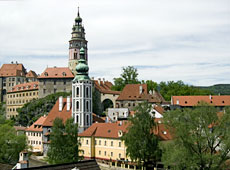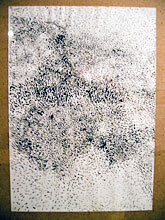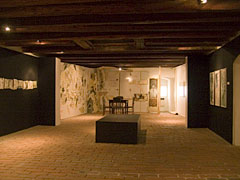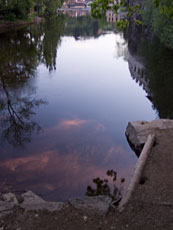Inside and Out
Cesky Krumlov is a small Czech town nestled on a dramatic bend in the Vltava River. Like any European city worth its salt, it has a dramatic castle on a hill and all the trappings of the once glorious feudal age, but with only one day to spend, a stopover on the way to Prague, I decided, rather than try to run around seeing a bunch of stuff in a hurry, to simply pick a place and spend the day there.
As it happened, Cesky Krumlov was home to the magnificent Egon Schiele museum, just the sort of place I could while away an afternoon relaxing and wandering aimlessly through an art gallery, for it was indeed more of gallery than a museum.  Schiele’s mother was born in Cesky Krumlov and the artist was drawn here by some compulsion of scenery and setting several times during his life, painting the narrow cobblestone streets and wonderful mixture of Gothic and art nouveau architecture (which what was actually new in his day). One of the most beautiful things about European towns is the rich array of vibrant color schemes you see on even the most ordinary of buildings. The attention to detail that makes the difference between a building and work of art was everywhere in Cesky Krumlov, from the delicate pink and red complements of a fine dovetailed corner, to the white plaster and oak beams of the Egon Schiele museum, which, despite geometric differences, looked not unlike the Globe Theatre in London.
Schiele’s mother was born in Cesky Krumlov and the artist was drawn here by some compulsion of scenery and setting several times during his life, painting the narrow cobblestone streets and wonderful mixture of Gothic and art nouveau architecture (which what was actually new in his day). One of the most beautiful things about European towns is the rich array of vibrant color schemes you see on even the most ordinary of buildings. The attention to detail that makes the difference between a building and work of art was everywhere in Cesky Krumlov, from the delicate pink and red complements of a fine dovetailed corner, to the white plaster and oak beams of the Egon Schiele museum, which, despite geometric differences, looked not unlike the Globe Theatre in London.
 The first time Schiele came to Cesky Krumlov he lived here for several years. It’s entirely possible he would have lived here forever were it not that the otherwise conservative town more or less ran him out for what the history books loosely refer to has his “lifestyle.” I don’t propose to know exactly what Schiele’s lifestyle entailed, but it probably didn’t help that his primary work at the time was a series of oils and sketches of nude pubescent girls. Europe, for all its supposed open-mindedness on art, has had its moments of prudishness. Walking the streets just adjacent the town square it wasn’t hard to image Schiele being out of place here and from what I know of his life, he probably made little attempt to hide anything, for he seemed to live as he painted, openly, not provoking, but perhaps confused and somewhat dismayed that not everyone found the same joys in life that he had discovered.
The first time Schiele came to Cesky Krumlov he lived here for several years. It’s entirely possible he would have lived here forever were it not that the otherwise conservative town more or less ran him out for what the history books loosely refer to has his “lifestyle.” I don’t propose to know exactly what Schiele’s lifestyle entailed, but it probably didn’t help that his primary work at the time was a series of oils and sketches of nude pubescent girls. Europe, for all its supposed open-mindedness on art, has had its moments of prudishness. Walking the streets just adjacent the town square it wasn’t hard to image Schiele being out of place here and from what I know of his life, he probably made little attempt to hide anything, for he seemed to live as he painted, openly, not provoking, but perhaps confused and somewhat dismayed that not everyone found the same joys in life that he had discovered.
 I’ve never been one to pay to much attentions to the details of curation, everything from the work selected to the way it’s lit and hung, but for the first time I realized how important all those tiny little decisions are to the experience we the viewers come away with and the curation at the Egon Schiele museum was nothing short of genius (for an example of terrible curation stop by the pompous and ill-conceived J. Paul Getty museum in Los Angeles).
I’ve never been one to pay to much attentions to the details of curation, everything from the work selected to the way it’s lit and hung, but for the first time I realized how important all those tiny little decisions are to the experience we the viewers come away with and the curation at the Egon Schiele museum was nothing short of genius (for an example of terrible curation stop by the pompous and ill-conceived J. Paul Getty museum in Los Angeles).
In addition to the permanent Schiele collection, the museum has several exhibitions as well which during the time of my visit were sketches and paintings by Alberto Giacometti and Eva Prokopcova. Giacometti’s work was a mixed bag, some of his paintings weren’t worth the cost of the oils he bought to make them, but one remarkable series of sketches redeemed him. A “graphic cycle” as the museum called it, entitled Paris Without End, featured the charcoal sketches Giacometti made toward the end of his life (most of which he spent in Paris). Displayed as the facing pages of a large sketchbook, the works were intended to become lithographs but that never happened and apparently the whole sequence had never been displayed together in its original form. Giacometti’s Paris Without End formed a kind of walking tour of the city in sketch form, marvelously detailed and yet extraordinarily minimalist as well. I’ve developed a fascination with negative space and Giacometti was a marvelous study in what can be created by a few simple lines organizing an otherwise blank page to reveal a small scene of a Parisian side street, an awning in three strokes of pen, a lamppost in the brief blur of charcoal. Walking around the display, which was laid out side by side around a massive white walled room, I had the feeling of having accompanied Giacometti on a walk around Paris during which he might have paused to note something, trace out an outline, remark on a scene. As one continuous experience, that is, all the sketches taken as a whole, the sketches felt like an intensely personal look into another person’s soul, to see for a moment how they view the world. Though I knew nothing of him when I arrived at the museum, I couldn’t shake the feeling on leaving that we had known each other well and can see myself at some point strolling down an alley in Montparnesse and thinking to myself, oh yes, this is where Alberto stopped to sketch the girl stepping off the train, where he huddled under the cafe awning in the rain to trace out the splash of auto tires on uneven cobblestones. But in spite of the intimate nature of the works, or perhaps because of it, the sketches are not off putting or insular, but have an openness rather like a fun filled confession to which all were invited.
The other artist on display was a local Czech artist named Eva Prokopcova whose abstract sketches filled the one odd and out of place room in the museum, on the ground floor, a strangely modern industrial feeling room with bare walls and floor to ceiling windows which unfortunately created a good bit of glare. Upstairs was another room of her oil paintings  which displayed chronologically around the room and gave a fascinating glimpse into the progression of the artist, both what changed and what remains the same. On first glance it was easy to see that Prokopcova had been moving away from realistic forms for some time and by the time I reached the far side of the room the canvases bore a stamp of abstraction and fascination with form that owed no small debt to Jackson Pollock, if not in style at least in underlying assumptions and conceptualization of those assumptions. And yet her work is nothing like Pollack’s, where he swirled into increasingly muddy tones she seemed to be moving toward brighter and brighter colors and more contrasting tones, colors that exploded to reveal forms you might say.
which displayed chronologically around the room and gave a fascinating glimpse into the progression of the artist, both what changed and what remains the same. On first glance it was easy to see that Prokopcova had been moving away from realistic forms for some time and by the time I reached the far side of the room the canvases bore a stamp of abstraction and fascination with form that owed no small debt to Jackson Pollock, if not in style at least in underlying assumptions and conceptualization of those assumptions. And yet her work is nothing like Pollack’s, where he swirled into increasingly muddy tones she seemed to be moving toward brighter and brighter colors and more contrasting tones, colors that exploded to reveal forms you might say.
The silence of the massive attic hall began to feel slightly oppressive to me after a while and so I wandered through low arched doorway to a smaller room which had one final, separate collection of works by Prokopova, a number of small eight by ten charcoals mounted one after the other, frame touching frame, and encircling the entire room at roughly chest height. Many of these had the most warmth and joy of anything in the museum, Schiele included, and I spent considerable time, circling the room twice to study the exquisite, chaotic stabs and blotches of ink that looked somehow contented in the afternoon light which streamed in through the attic window behind me. It was not unlike the inside of a ring I thought at one point. I sat down in a solitary chair in the middle of the room and tried to imagine myself sitting in the middle of a ring, as if the room were a transparent finger and I inside it. I spent some time considering whether this observation was purely my imagination or perhaps an intension of the artist to transport us, like Sun Ra perhaps, to some ringed planet where the senses spin and mingle more freely.
I sat for a while in an oversized armchair alone in the center of the small attic room watching the single beam of sunlight slowly move across the floorboards while I scribbled a few notes and listened to some music on my headphones.  I thought of Kindinsky and his synesthesia, the man whose paintbrush sang to him, who painted in cello blue and trumpet reds. I’ve never heard a color, though I do think colors smell differently. The room with red walls has a scent far removed from the cool afternoon creams and peaches of the dining room in the house where I once lived. I was too old for the house as it turned out, but I remember the sunlight reflection off the stainless steel kitchen sink sang to me some mornings.
I thought of Kindinsky and his synesthesia, the man whose paintbrush sang to him, who painted in cello blue and trumpet reds. I’ve never heard a color, though I do think colors smell differently. The room with red walls has a scent far removed from the cool afternoon creams and peaches of the dining room in the house where I once lived. I was too old for the house as it turned out, but I remember the sunlight reflection off the stainless steel kitchen sink sang to me some mornings.
So far as I know Schiele did not hear color either and perhaps that’s why he had to make it sing on the canvas, a cool dark sound you can almost hear drifting in the window from Cesky Krumlov’s streets below.
It was the mingling sausage scents and hunger that finally drew me back downstairs and out into the streets where a synesthetic wonderland was dressed in evening light and sounded like a river running over…  I decided as I left the Schiele museum behind that we are all synthesists in a way, there are not those clear lines between our sense that we imagine, one cannot see without hearing and tasting and touching and smelling, the sun now before me visible between the narrow slices of buildings the reflection of orange light in the waters of the river, is inseparable from the taste of Budvar, the smell of mustard and shoe polish, the sound of bells, the flapping of pigeon wings, the taste of sausage, the cool damp of the evening air, the gurgle of the river, the voices drifting out of windows, the fine inlay work on the tile floor, the shape of my chair, the yellow brown walls, the schoolgirls laughing, the waitress’s perfume, the man in the corner singing softly with a cigar between his lips; everything is always happening everywhere.
I decided as I left the Schiele museum behind that we are all synthesists in a way, there are not those clear lines between our sense that we imagine, one cannot see without hearing and tasting and touching and smelling, the sun now before me visible between the narrow slices of buildings the reflection of orange light in the waters of the river, is inseparable from the taste of Budvar, the smell of mustard and shoe polish, the sound of bells, the flapping of pigeon wings, the taste of sausage, the cool damp of the evening air, the gurgle of the river, the voices drifting out of windows, the fine inlay work on the tile floor, the shape of my chair, the yellow brown walls, the schoolgirls laughing, the waitress’s perfume, the man in the corner singing softly with a cigar between his lips; everything is always happening everywhere.
Thoughts?
Please leave a reply:
All comments are moderated, so you won’t see it right away. And please remember Kurt Vonnegut's rule: “god damn it, you’ve got to be kind.” You can use Markdown or HTML to format your comments. The allowed tags are
<b>, <i>, <em>, <strong>, <a>. To create a new paragraph hit return twice.